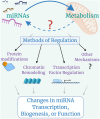MicroRNAs: At the Interface of Metabolic Pathways and Inflammatory Responses by Macrophages
- PMID: 32922393
- PMCID: PMC7456828
- DOI: 10.3389/fimmu.2020.01797
MicroRNAs: At the Interface of Metabolic Pathways and Inflammatory Responses by Macrophages
Abstract
Macrophages are key cells of the innate immune system with functional roles in both homeostatic maintenance of self-tissues and inflammatory responses to external stimuli, including infectious agents. Recent advances in metabolic research have revealed that macrophage functions rely upon coordinated metabolic programs to regulate gene expression, inflammation, and other important cellular processes. Polarized macrophages adjust their use of nutrients such as glucose and amino acids to meet their changing metabolic needs, and this in turn supports the functions of the activated macrophage. Metabolic and inflammatory processes have been widely studied, and a crucial role for their regulation at the post-transcriptional level by microRNAs (miRNAs) has been identified. miRNAs govern many facets of macrophage biology, including direct targeting of metabolic regulators and inflammatory pathways. This review will integrate emerging data that support an interplay between miRNAs and metabolism during macrophage inflammatory responses, highlighting critical miRNAs and miRNA families. Additionally, we will address the implications of these networks for human disease and discuss emerging areas of research in this field.
Keywords: immunometabolism; inflammation; macrophage; macrophage polarization; metabolism; microRNA.
Copyright © 2020 Nelson and O'Connell.
Figures



References
Publication types
MeSH terms
Substances
Grants and funding
LinkOut - more resources
Full Text Sources

